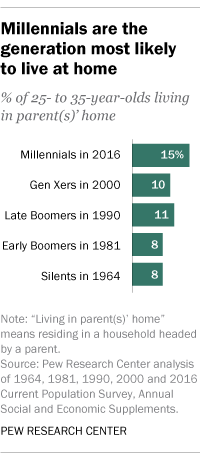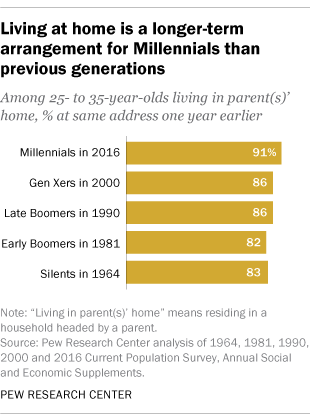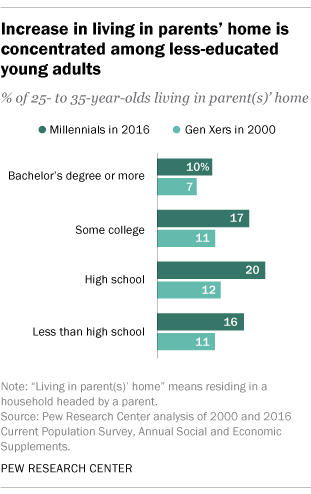
Through both recession and recovery, the share of young adults living in their parents’ home continues to rise. Today’s young adults are also more likely to be at home for an extended stay compared with previous generations of young adults who resided with their parents, according to a Pew Research Center analysis of U.S. census data.
As of 2016, 15% of 25- to 35-year-old Millennials were living in their parents’ home. This is 5 percentage points higher than the share of Generation Xers who lived in their parents’ home in 2000 when they were the same age (10%), and nearly double the share of the Silent Generation who lived at home in 1964 (8%).
It doesn’t appear that a lack of jobs is keeping Millennials at home. As of the first quarter of 2016 (when the living arrangements data were collected), only 5.1% of older young adults were unemployed, down from 10.1% in the first quarter of 2010. Yet the share of 25- to 35-year-olds living at home rose during that span, increasing from 12% in 2010 to 15% in 2016.
The living arrangements data are based on the Census Bureau’s Annual Social and Economic Supplement, collected in March. These data also serve as the basis for the nation’s long-running statistics on geographic mobility. Using the mobility information provides some insight into the extent to which the nation’s young adults are moving in and out of certain living arrangements. (The supplement does not accurately capture moves to and from college dormitories and may not accurately estimate the mobility of a population likely to live in a dorm. That is why 18- to 24-year-olds are not included in this analysis.)

Millennials – whether living with their parents or not – are moving significantly less often than earlier generations of young adults. Among 25- to 35-year-old Millennials who were living at home in 2016, 91% reported that they resided at the same address one year earlier. This does not preclude the possibility that the young adult moved out and “boomeranged” back in the intervening year (perhaps multiple times); the data simply indicate that they lived with their parent or parents one year earlier as well.
These long-term stays at home represent an uptick from the past. Among Gen Xers living at home in 2000, 86% reported living at that address one year earlier. Among similarly aged members of the Silent Generation living at home in 1964, 83% reported living at that address one year earlier.
Other estimates of the length of time young adults spend living with their parents show the same trend.
Among young adults who moved back in with their parents (implying that they had moved out at least once), the median estimated length of time spent living with their parents was three years, according to research based on credit report data. This research found that the median duration of young adults living with their parents increased by six months from 2005 to 2013.

The increased prevalence of living with mom and/or dad is more prominent among less-educated young adults. In 2016, only 10% of Millennials who had completed at least a bachelor’s degree lived at home, compared with 7% of college-educated Gen Xers who lived at home in 2000. By contrast, 20% of young adults with no more than a high school diploma lived in their parents’ home in 2016, up from 12% of Gen Xers in 2000.
A variety of factors may influence young adults’ decisions to live at home, including their success in the labor market, the cost of living independently, and their debt obligations. The fact that less-educated young adults are much less likely to live independently than their more educated counterparts comports with the basic patterns of employment success in the U.S. labor market. Wages and employment have declined for less-educated young adults since the 1970s, whereas young college-educated workers have experienced improving outcomes in the job market, especially for those with advanced degrees. Young adults with higher wages are less likely to be living at home.
